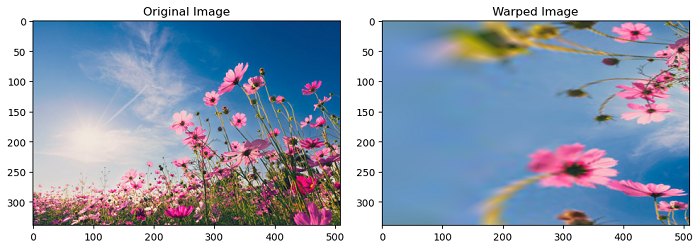
- Scikit Image – Introduction
- Scikit Image - Image Processing
- Scikit Image - Numpy Images
- Scikit Image - Image datatypes
- Scikit Image - Using Plugins
- Scikit Image - Image Handlings
- Scikit Image - Reading Images
- Scikit Image - Writing Images
- Scikit Image - Displaying Images
- Scikit Image - Image Collections
- Scikit Image - Image Stack
- Scikit Image - Multi Image
- Scikit Image - Data Visualization
- Scikit Image - Using Matplotlib
- Scikit Image - Using Ploty
- Scikit Image - Using Mayavi
- Scikit Image - Using Napari
- Scikit Image - Color Manipulation
- Scikit Image - Alpha Channel
- Scikit Image - Conversion b/w Color & Gray Values
- Scikit Image - Conversion b/w RGB & HSV
- Scikit Image - Conversion to CIE-LAB Color Space
- Scikit Image - Conversion from CIE-LAB Color Space
- Scikit Image - Conversion to luv Color Space
- Scikit Image - Conversion from luv Color Space
- Scikit Image - Image Inversion
- Scikit Image - Painting Images with Labels
- Scikit Image - Contrast & Exposure
- Scikit Image - Contrast
- Scikit Image - Contrast enhancement
- Scikit Image - Exposure
- Scikit Image - Histogram Matching
- Scikit Image - Histogram Equalization
- Scikit Image - Local Histogram Equalization
- Scikit Image - Tinting gray-scale images
- Scikit Image - Image Transformation
- Scikit Image - Scaling an image
- Scikit Image - Rotating an Image
- Scikit Image - Warping an Image
- Scikit Image - Affine Transform
- Scikit Image - Piecewise Affine Transform
- Scikit Image - ProjectiveTransform
- Scikit Image - EuclideanTransform
- Scikit Image - Radon Transform
- Scikit Image - Line Hough Transform
- Scikit Image - Probabilistic Hough Transform
- Scikit Image - Circular Hough Transforms
- Scikit Image - Elliptical Hough Transforms
- Scikit Image - Polynomial Transform
- Scikit Image - Image Pyramids
- Scikit Image - Pyramid Gaussian Transform
- Scikit Image - Pyramid Laplacian Transform
- Scikit Image - Swirl Transform
- Scikit Image - Morphological Operations
- Scikit Image - Erosion
- Scikit Image - Dilation
- Scikit Image - Black & White Tophat Morphologies
- Scikit Image - Convex Hull
- Scikit Image - Generating footprints
- Scikit Image - Isotopic Dilation & Erosion
- Scikit Image - Isotopic Closing & Opening of an Image
- Scikit Image - Skelitonizing an Image
- Scikit Image - Morphological Thinning
- Scikit Image - Masking an image
- Scikit Image - Area Closing & Opening of an Image
- Scikit Image - Diameter Closing & Opening of an Image
- Scikit Image - Morphological reconstruction of an Image
- Scikit Image - Finding local Maxima
- Scikit Image - Finding local Minima
- Scikit Image - Removing Small Holes from an Image
- Scikit Image - Removing Small Objects from an Image
- Scikit Image - Filters
- Scikit Image - Image Filters
- Scikit Image - Median Filter
- Scikit Image - Mean Filters
- Scikit Image - Morphological gray-level Filters
- Scikit Image - Gabor Filter
- Scikit Image - Gaussian Filter
- Scikit Image - Butterworth Filter
- Scikit Image - Frangi Filter
- Scikit Image - Hessian Filter
- Scikit Image - Meijering Neuriteness Filter
- Scikit Image - Sato Filter
- Scikit Image - Sobel Filter
- Scikit Image - Farid Filter
- Scikit Image - Scharr Filter
- Scikit Image - Unsharp Mask Filter
- Scikit Image - Roberts Cross Operator
- Scikit Image - Lapalace Operator
- Scikit Image - Window Functions With Images
- Scikit Image - Thresholding
- Scikit Image - Applying Threshold
- Scikit Image - Otsu Thresholding
- Scikit Image - Local thresholding
- Scikit Image - Hysteresis Thresholding
- Scikit Image - Li thresholding
- Scikit Image - Multi-Otsu Thresholding
- Scikit Image - Niblack and Sauvola Thresholding
- Scikit Image - Restoring Images
- Scikit Image - Rolling-ball Algorithm
- Scikit Image - Denoising an Image
- Scikit Image - Wavelet Denoising
- Scikit Image - Non-local means denoising for preserving textures
- Scikit Image - Calibrating Denoisers Using J-Invariance
- Scikit Image - Total Variation Denoising
- Scikit Image - Shift-invariant wavelet denoising
- Scikit Image - Image Deconvolution
- Scikit Image - Richardson-Lucy Deconvolution
- Scikit Image - Recover the original from a wrapped phase image
- Scikit Image - Image Inpainting
- Scikit Image - Registering Images
- Scikit Image - Image Registration
- Scikit Image - Masked Normalized Cross-Correlation
- Scikit Image - Registration using optical flow
- Scikit Image - Assemble images with simple image stitching
- Scikit Image - Registration using Polar and Log-Polar
- Scikit Image - Feature Detection
- Scikit Image - Dense DAISY Feature Description
- Scikit Image - Histogram of Oriented Gradients
- Scikit Image - Template Matching
- Scikit Image - CENSURE Feature Detector
- Scikit Image - BRIEF Binary Descriptor
- Scikit Image - SIFT Feature Detector and Descriptor Extractor
- Scikit Image - GLCM Texture Features
- Scikit Image - Shape Index
- Scikit Image - Sliding Window Histogram
- Scikit Image - Finding Contour
- Scikit Image - Texture Classification Using Local Binary Pattern
- Scikit Image - Texture Classification Using Multi-Block Local Binary Pattern
- Scikit Image - Active Contour Model
- Scikit Image - Canny Edge Detection
- Scikit Image - Marching Cubes
- Scikit Image - Foerstner Corner Detection
- Scikit Image - Harris Corner Detection
- Scikit Image - Extracting FAST Corners
- Scikit Image - Shi-Tomasi Corner Detection
- Scikit Image - Haar Like Feature Detection
- Scikit Image - Haar Feature detection of coordinates
- Scikit Image - Hessian matrix
- Scikit Image - ORB feature Detection
- Scikit Image - Additional Concepts
- Scikit Image - Render text onto an image
- Scikit Image - Face detection using a cascade classifier
- Scikit Image - Face classification using Haar-like feature descriptor
- Scikit Image - Visual image comparison
- Scikit Image - Exploring Region Properties With Pandas
Scikit Image - Warping an image
Image warping refers to the process of transforming an image from its original coordinate space to a new coordinate space, typically to achieve geometric transformations. The goal is to remap the pixels of the input image to new positions in the output image, according to a specified transformation function. This process is commonly used in various image-processing tasks to achieve effects like rotation, scaling, and perspective transformations.
In scikit-image, The skimage.transform.warp(), skimage.transform.warp_coords() and skimage.transform.warp_polar() functions are used to perform image warping tasking in Pythons scikit-image library.
Using the skimage.transform.warp() function
The warp() function in scikit-image is used to warp an image based on a given coordinate transformation.
Syntax
Following is the syntax of this function −
skimage.transform.warp(image, inverse_map, map_args=None, output_shape=None, order=None, mode='constant', cval=0.0, clip=True, preserve_range=False)
Parameters
- image: The input image to be warped, represented as a NumPy array.
- inverse_map: The coordinate transformation that maps coordinates in the output image to their corresponding coordinates in the input image. This can be specified in different ways, depending on the dimensionality of the input image.
- map_args (optional): Keyword arguments passed to the inverse_map.
- output_shape (optional): The desired shape of the output image. By default, it preserves the shape of the input image.
- order (int, optional): The order of spline interpolation used during the rotation. The default value is 0 if the image.dtype is bool and 1 otherwise. The order must be in the range 0-5.
- order (optional): The order of interpolation used during warping.
- mode (optional): Determines how points outside the boundaries of the input image are filled. It can take values like 'constant', 'edge', 'symmetric', 'reflect', or 'wrap'.
- cval (optional): The value used for points outside the image when mode is set to 'constant.
- clip (optional): Specifies whether to clip the output to the range of values of the input image. It is enabled by default to avoid values outside the input range.
- preserve_range (optional): Specifies whether to keep the original range of values. If set to False, the input image is converted according to the conventions of img_as_float.
Return Value
It returns the warped output image, a double NumPy array representing the warped input image.
Example
Here is an example of using the skimage.transform.warp() function to warp an image using a geometric transform (fast).
from skimage.transform import SimilarityTransform, warp
from skimage import io
import matplotlib.pyplot as plt
# Load the input image
image = io.imread('Images/Tajmahal.jpg')
# Define the geometric transform (translation by 10 pixels upwards)
tform = SimilarityTransform(translation=(0, -10))
# Apply the warp using the defined transform
warped = warp(image, tform)
# Display the original and warped mages side by side
fig, axes = plt.subplots(1, 2, figsize=(10, 5))
axes[0].imshow(image)
axes[0].set_title('Original Image')
axes[1].imshow(warped)
axes[1].set_title('Warped Image')
# Show the plot
plt.tight_layout()
plt.show()
Output
On executing the above program, you will get the following output −
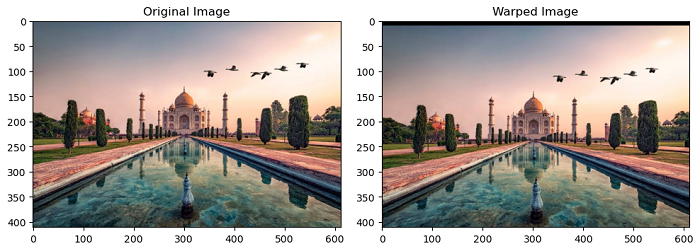
Example
The following example demonstrates how to warp an image using a custom callable (slow) using the skimage.transform.warp() function.
from skimage.transform import SimilarityTransform, warp
from skimage import io
import matplotlib.pyplot as plt
def shift_down(xy):
xy[:, 1] -= 50
return xy
# Load the input image
image = io.imread('Images/logo.jpg')
# Apply the warp using the defined transform
warped = warp(image, shift_down)
# Display the original and warped mages side by side
fig, axes = plt.subplots(1, 2, figsize=(10, 5))
axes[0].imshow(image)
axes[0].set_title('Original Image')
axes[1].imshow(warped)
axes[1].set_title('Warped Image')
# Show the plot
plt.tight_layout()
plt.show()
Output
On executing the above program, you will get the following output −
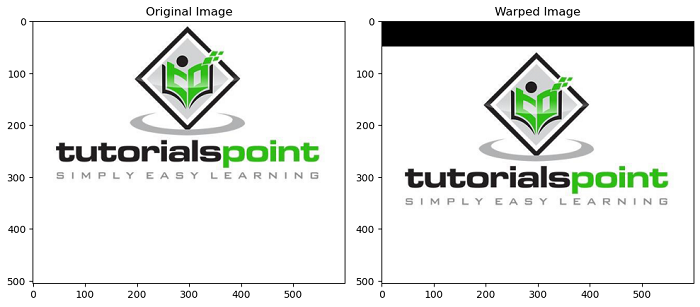
Example
In this example, we will use a 2D transformation matrix to represent a translation of 50 pixels in the vertical direction (upward).
from skimage.transform import SimilarityTransform, warp
from skimage import io
import matplotlib.pyplot as plt
import numpy as np
# Load the input image
image = io.imread('Images/logo.jpg')
# Define a 2D transformation matrix for translation (50 pixels upward)
matrix = np.array([[1, 0, 0], [0, 1, 50], [0, 0, 1]])
# Apply the warp using the transformation matrix
warped = warp(image, matrix)
# Display the original and warped mages side by side
fig, axes = plt.subplots(1, 2, figsize=(10, 5))
axes[0].imshow(image)
axes[0].set_title('Original Image')
axes[1].imshow(warped)
axes[1].set_title('Warped Image')
# Show the plot
plt.tight_layout()
plt.show()
Output
On executing the above program, you will get the following output −
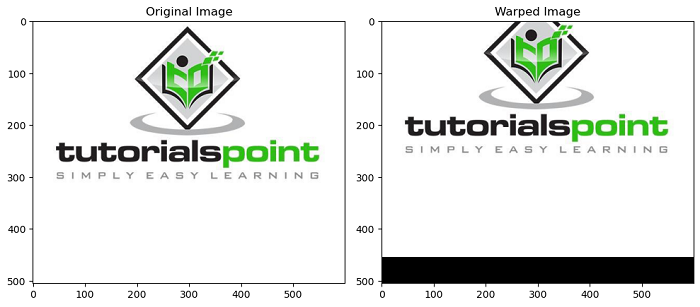
Using the skimage.transform.warp_coords() function
The warp_coords function is used to build the source coordinates for the output of a 2-D image warp. This function is provided separately from warp() to give users additional flexibility, allowing them to reuse specific coordinate mappings or use specific data types during the image-warping process. It returns the coordinates that can be passed to scipy.ndimage.map_coordinates to obtain the desired warped image.
Syntax
Following is the syntax of this function −
skimage.transform.warp_coords(coord_map, shape, dtype=<class 'numpy.float64'>)
Parameters
- coord_map: A callable (e.g., a GeometricTransform.inverse) that takes the output coordinates as input and returns the corresponding input coordinates. The input and output coordinates are both represented as a (P, 2) array, where P is the number of coordinates, and each element is a (row, col) pair.
- shape: A tuple representing the shape of the output image (rows, cols[, bands]).
- dtype: The data type for the return value. Sane choices are float32 or float64.
Return Value
It returns an array representing the coordinates for scipy.ndimage.map_coordinates. The shape of the coordinates is (ndim, rows, cols[, bands]), and the data type is determined by the dtype parameter.
Example
Here is an example to produce a coordinate map that shifts an image up and to the right using the skimage.transform.warp_coords() function.
from skimage.transform import warp_coords
from skimage import io
from scipy.ndimage import map_coordinates
import matplotlib.pyplot as plt
import numpy as np
def shift_up10_left20(xy):
return xy - np.array([-20, 10])[None, :]
# Load the input image
image = io.imread('Images/logo.jpg')
# Get the coordinates for the image warp using the coordinate map
coords = warp_coords(shift_up10_left20, image.shape)
# Perform the image warp using scipy.ndimage.map_coordinates
warped_image = map_coordinates(image, coords)
# Display the original and warped mages side by side
fig, axes = plt.subplots(1, 2, figsize=(10, 5))
axes[0].imshow(image)
axes[0].set_title('Original Image')
axes[1].imshow(warped_image)
axes[1].set_title('Warped Image')
# Show the plot
plt.tight_layout()
plt.show()
Output
On executing the above program, you will get the following output −
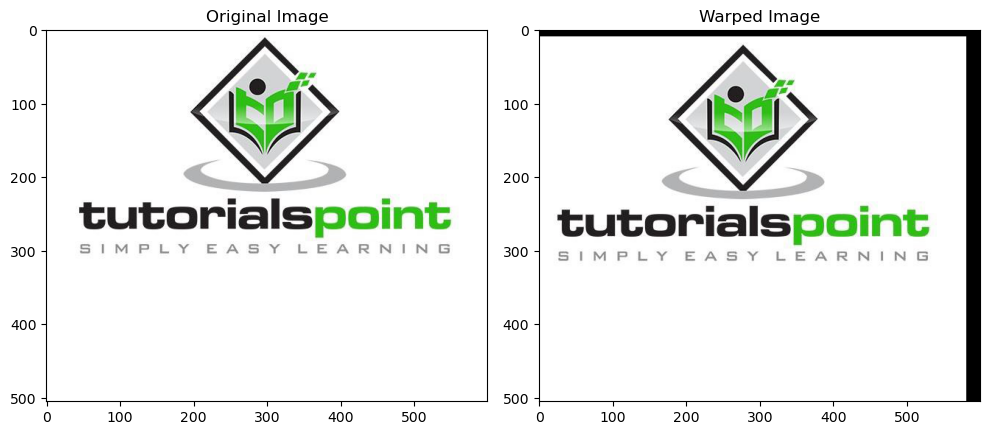
Using the skimage.transform.warp_polar function
The warp_polar() function is used to remap an input image to polar or log-polar coordinate space.
Syntax
Following is the syntax of this function −
skimage.transform.warp_polar(image, center=None, *, radius=None, output_shape=None, scaling='linear', channel_axis=None, **kwargs)
Parameters
- image: The input image to be warped. It should be a 2-D array for grayscale images or a 3-D array for color images (channel_axis parameter should be specified).
- center: A tuple representing the center point in the image, which serves as the origin in Cartesian space for the polar transformation. If not provided, the center is assumed to be the center point of the image.
- radius: The radius of the circle that bounds the area to be transformed.
- output_shape: A tuple representing the shape of the output warped image in polar coordinates.
- scaling: Specify whether the image warp is polar ('linear') or log-polar ('log'). The default is 'linear'.
- channel_axis: An integer or None, indicating the axis of the array that corresponds to channels. If None, the image is assumed to be a grayscale image. If specified, the function accepts 3-D arrays (for color images) with the specified axis as the channel axis.
Return Value
It returns a ndarray representing the polar or log-polar warped image.
Example
The following example demonstrates how to perform a basic polar warp on a grayscale image using the warp_polar() function.
from skimage import io
from skimage.transform import warp_polar
import matplotlib.pyplot as plt
# Load the input image as gray-scale image
image = io.imread('Images/flowers.jpg', as_gray=True)
# Perform a basic polar warp on the grayscale image
warped = warp_polar(image)
# Display the original and warped mages side by side
fig, axes = plt.subplots(1, 2, figsize=(10, 5))
axes[0].imshow(image)
axes[0].set_title('Original Image')
axes[1].imshow(warped)
axes[1].set_title('Warped Image')
# Show the plot
plt.tight_layout()
plt.show()
Output
On executing the above program, you will get the following output −
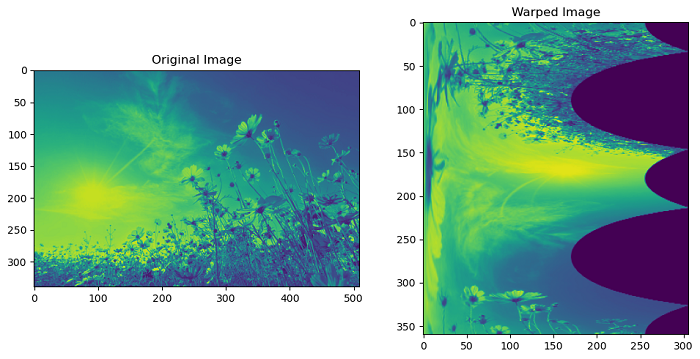
Example
The following example demonstrates how to perform the log-polar warp on a grayscale image using the warp_polar() function.
from skimage import io
from skimage.transform import warp_polar
import matplotlib.pyplot as plt
# Load the input image as gray-scale image
image = io.imread('Images/flowers.jpg', as_gray=True)
# Perform the log-polar warp on the grayscale image
warped = warp_polar(image, scaling='log')
# Display the original and warped mages side by side
fig, axes = plt.subplots(1, 2, figsize=(10, 5))
axes[0].imshow(image)
axes[0].set_title('Original Image')
axes[1].imshow(warped)
axes[1].set_title('Warped Image')
# Show the plot
plt.tight_layout()
plt.show()
Output
On executing the above program, you will get the following output −
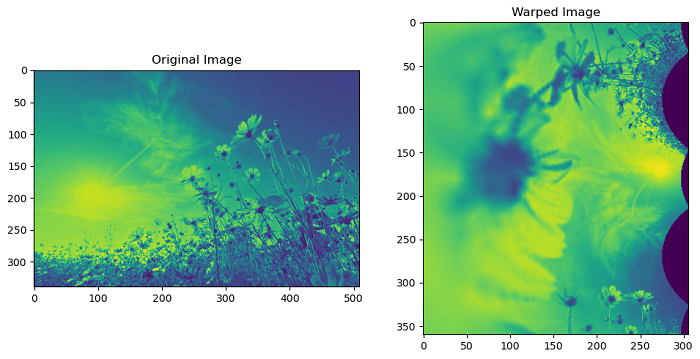
Example
The following example demonstrates how to perform a log-polar warp on the color image while specifying the center, radius, and output shape using the warp_polar() function.
from skimage import io
from skimage.transform import warp_polar
import matplotlib.pyplot as plt
# Load the input image as gray-scale image
image = io.imread('Images/flowers.jpg')
# Perform a log-polar warp on the color image while specifying the center, radius, and output shape
warped = warp_polar(image, center=(150, 300), radius=100, output_shape=image.shape, scaling='log', channel_axis=-1)
# Display the original and warped mages side by side
fig, axes = plt.subplots(1, 2, figsize=(10, 5))
axes[0].imshow(image)
axes[0].set_title('Original Image')
axes[1].imshow(warped)
axes[1].set_title('Warped Image')
# Show the plot
plt.tight_layout()
plt.show()
Output
On executing the above program, you will get the following output −
